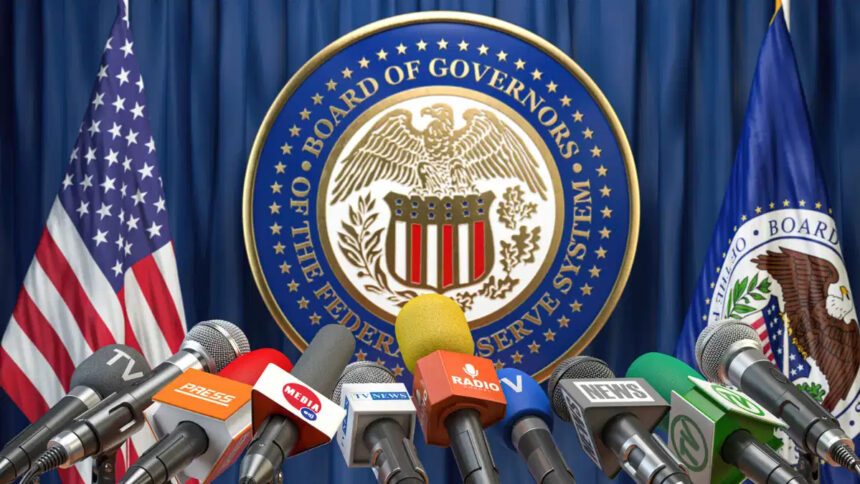The Federal Reserve (Fed) is set to announce its first interest rate cut in over two years on September 18, 2024, marking a potential shift in U.S. monetary policy. With inflation slowly approaching the Fed’s 2% target and a weakening job market, this anticipated cut signifies the end of a prolonged period of high interest rates that have challenged borrowers while rewarding savers. However, the uncertainty surrounding the size of the cut—either 25 or 50 basis points (bps)—has sparked significant debate among economists, investors, and market analysts.
This blog will explore the implications of the Fed’s rate cut, examine how it could impact various sectors of the economy, and assess its global ramifications, particularly in relation to the Indian economy, oil prices, and global markets.
A Recap of the Fed’s Tight Monetary Policy
The Federal Reserve began tightening its monetary policy in March 2022 to combat the worst inflation outbreak the U.S. had experienced in four decades. By raising interest rates from near-zero levels to a target range of 5.25%-5.50%, the Fed sought to cool inflationary pressures while maintaining economic stability. These rate hikes were among the most aggressive in recent memory, with the Fed raising rates by 5.25 percentage points over a span of just 18 months.
For borrowers, this meant higher costs. Mortgage rates, for instance, rose sharply, with the average rate for a 30-year fixed mortgage climbing from 4.29% in March 2022 to 6.12% by mid-September 2024 . Home equity loans and credit card interest rates also surged, making it more expensive for consumers to borrow. Conversely, savers benefitted from these higher rates, with returns on savings accounts, certificates of deposit (CDs), and money market funds increasing significantly .
Now, however, with inflation subsiding and signs of economic softening—particularly in the labor market—the Fed is ready to reverse course.
The Size of the Rate Cut: 25 or 50 Basis Points?
The key question now is whether the Fed will cut rates by 25 or 50 basis points. According to Fed funds futures data, there is a 55% chance of a 50-basis point cut and a 45% probability of a smaller 25-basis point cut . While a 50-basis point reduction could provide immediate relief to borrowers, it also raises concerns about the Fed’s confidence in the economy’s ability to achieve a “soft landing.” Bank of America’s senior U.S. economist, Aditya Bhave, has warned that a 50-basis point cut could indicate that the Fed is less optimistic about the economy’s ability to avoid a recession .
Impact on Borrowers: Relief or Short-Term Gain?

For borrowers, a rate cut will likely bring relief, particularly for those with variable interest loans, such as credit cards and adjustable-rate mortgages. A reduction in the Fed’s target rate typically leads to lower borrowing costs across the board. For homeowners, this could mean lower mortgage rates, making homebuying or refinancing more affordable. Home equity loan rates
are also expected to decrease, providing homeowners with access to cheaper credit, which could stimulate further investments in home improvements or other major expenses.
Moreover, businesses with outstanding loans or credit lines could also benefit from lower rates, making it more affordable to borrow for expansion, hiring, or capital investments. Lower borrowing costs might even spur some companies to increase their investments, potentially providing a much-needed boost to productivity and economic growth. However, it’s essential to consider that the impact on borrowers will vary depending on the size of the rate cut.
A 25-basis Point Cut: A More Cautious Approach
A 25-basis point rate cut would signal that the Fed is cautiously optimistic about the economy. While inflation is coming down, the job market is showing signs of weakness, and there are ongoing concerns about the global economic outlook. By opting for a smaller rate cut, the Fed could aim to strike a balance between supporting the economy and maintaining vigilance over inflation risks.
For borrowers, a 25-basis point cut will provide some relief, but it may not be as substantial or immediate as a 50-basis point reduction. Mortgage rates, for example, may only see marginal decreases, and credit card interest rates might not fall significantly. However, a 25-basis point cut may be enough to signal to consumers and businesses that the Fed is committed to ensuring economic stability without taking overly aggressive actions.
A 50-basis Point Cut: Strong Signal, But At What Cost?
On the other hand, a 50-basis point cut would send a strong signal that the Fed is more concerned about the potential risks of an economic slowdown than about inflation. This larger reduction would likely lead to more substantial decreases in borrowing costs across the board. For borrowers, this could mean a more immediate impact on mortgage rates, credit card rates, and home equity loans, providing a much-needed boost to consumer spending and business investment.
However, the downside to a larger rate cut is the potential for signaling that the economy is in worse shape than previously anticipated. Investors may initially rally in response to lower rates, but as Bank of America’s Aditya Bhave noted, this could be followed by concerns about the Fed’s confidence in achieving a “soft landing.” If the Fed is cutting rates by 50 basis points, it could be seen as an acknowledgment that the economy is on shakier ground than expected, which could lead to increased market volatility.
Global Implications: From India to China
The Crypto Market Is On High Alert Ahead Of The Federal Reserve's Interest Rate Decision Today At 6:00 PM GMT.
A rate cut is widely anticipated, with expectations of the Fed funds rate dropping from 5.5% to 5%.
This could be a bullish sign for the market, especially if the Fed… pic.twitter.com/OMvnywhC6t
— HEINRICH (@HeinrichDefi) September 18, 2024The impact of the Fed’s interest rate cut won’t be confined to U.S. shores. Global markets, particularly emerging economies like India, will also feel the effects of the Fed’s decision.
The Indian Economy: Following the Fed’s Lead
India, one of the world’s largest emerging markets, is closely watching the Fed’s next move. Historically, the Reserve Bank of India (RBI) has often followed the Fed’s lead when it comes to monetary policy. A rate cut by the Fed could prompt the RBI to reduce its own interest rates, providing a much-needed stimulus to India’s economy.
As Palka Arora Chopra, Director of Master Capital Services Ltd., pointed out, a Fed rate reduction typically weakens the U.S. dollar, which could result in increased liquidity and lower borrowing costs globally. For India, this could be particularly beneficial to sectors such as IT, Banking, Financial Services and Insurance (BFSI), Auto, and Realty, which would likely see a positive impact from the combination of cheaper borrowing costs and a stronger Indian rupee.
Furthermore, rate cuts by the RBI could enhance liquidity in Indian markets, attract capital inflows, and provide additional support to the country’s economic growth. In recent years, India’s economy has faced headwinds from rising inflation and slowing growth. A Fed rate cut, followed by similar actions from the RBI, could be a critical step toward reversing this trend and fostering a more robust economic recovery.
China’s Economic Struggles and Global Spillovers
China, the world’s second-largest economy, is also a key player in the global economic picture. Recent data from China has highlighted concerns about slowing industrial output and weakening consumption and investment. These challenges have prompted the People’s Bank of China (PBOC) to signal that fighting deflation will become a priority, with additional monetary easing likely in the near future.
The Fed’s rate cut could exacerbate challenges for China by putting downward pressure on the U.S. dollar, which may lead to capital outflows from emerging markets like China as investors seek higher returns elsewhere. Moreover, the weakening Chinese economy has already led to reduced demand for commodities, which could have broader implications for global markets, especially those heavily reliant on exports to China.
Ray Dalio, founder of Bridgewater Associates, noted that while the Fed’s rate cut may not have a significant long-term impact on global markets, China’s economic slowdown remains a critical risk. Dalio emphasized that global investors are concerned about China’s ability to meet its growth targets, and further economic softening in China could lead to broader instability across global markets.
Sectoral Impacts: Who Wins and Who Loses?
The anticipated Fed rate cut will have varying effects across different sectors of the U.S. economy. While some industries stand to benefit, others may face challenges as a result of lower borrowing costs and shifting market dynamics.
Winners: Real Estate, Financials, and Consumer Discretionary
- Real Estate: One of the primary beneficiaries of a Fed rate cut is the real estate sector. Lower interest rates mean cheaper mortgages, which can boost demand for housing and potentially drive up home prices. Homebuilders and real estate companies could see increased business as more consumers take advantage of lower borrowing costs to purchase homes or refinance existing mortgages.
- Financials: While lower interest rates typically reduce the profitability of banks’ lending operations, they also create opportunities for increased lending volumes. Banks and financial institutions may see a surge in demand for loans, credit cards, and mortgages as consumers and businesses take advantage of lower borrowing costs.
- Consumer Discretionary: Lower interest rates often encourage consumer spending, particularly on big-ticket items such as cars, appliances, and electronics. The auto industry, for instance, could benefit from lower auto loan rates, while retailers may see increased consumer demand for high-cost items that are often financed with credit.
Losers: Tech and Commodities

- Technology: The tech sector, which has seen significant growth over the past decade, may face challenges in the wake of a Fed rate cut. Many large-cap tech stocks have benefited from a strong dollar and low borrowing costs, but as interest rates fall, profit-taking may lead to volatility in tech stocks. This could also be compounded by concerns about slowing global growth, particularly in key markets like China.
- Commodities: The commodities market, particularly oil and precious metals, may experience price fluctuations as a result of the Fed’s rate cut. While lower interest rates could stimulate demand for commodities in the short term, global economic uncertainty—particularly in China—could lead to weaker demand over the long run. For example, oil prices have remained volatile amid concerns about global demand, and lower refinery margins suggest sluggish demand for energy products.
Conclusion: Navigating an Uncertain Future
The upcoming Fed interest rate decision marks a pivotal moment for the U.S. and global economies. Whether the Fed cuts rates by 25 or 50 basis points, the effects will be felt across markets, impacting borrowers, savers, businesses, and investors alike. While a rate cut could provide relief to borrowers and boost sectors like real estate and financials, it also raises concerns about the broader economic outlook and the potential for a global slowdown, particularly in key economies like China and India.
As markets prepare for the Fed’s decision, investors and policymakers must remain vigilant, balancing the short-term benefits of lower rates with the long-term risks of economic instability. Whether the Fed can successfully engineer a “soft landing” remains to be seen, but one thing is clear: the world will be watching closely.





